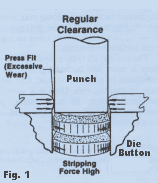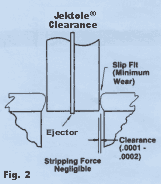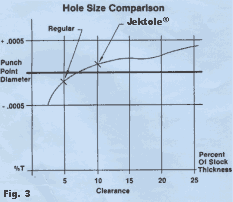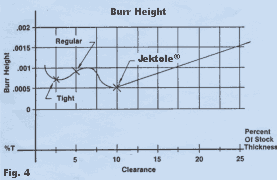
 The process of punching a hole is one of impact and loading.
The cutting edges of the punch and die concentrate the punching load on the stock confined between the cutting edges. The process of punching a hole is one of impact and loading.
The cutting edges of the punch and die concentrate the punching load on the stock confined between the cutting edges.To punch a hole, the stock being perforated must fail. In that process, the punch and die cutting edges are under extreme pressure which can cause chipping, wear, and even breakage. Proper die clearance is critical to successful hole punching is.  Die clearance is the distance between
the punch cutting edge and the die button cutting edge. It is commonly referred to as
clearance per side, and is expressed as a percentage of
stock thickness.
Die clearance is the distance between
the punch cutting edge and the die button cutting edge. It is commonly referred to as
clearance per side, and is expressed as a percentage of
stock thickness.For many years, 5% per side die clearance was used. That Regular Clearance was used on nearly all types of steel stock. It resulted in an acceptable burr and good slug retention, but wear on the punch was excessive. Today,7% or 8% clearance is commonly used, due in part to the availability of Jektole ejector punches. It is well known that the punch determines the size of the perforated hole. But the clearance has an effect on the hole size too. |
 If
the clearance is too tight (Figure 1), the hole can be as much as
.0005" smaller than the punch. The punch is therefore press-fit into
the perforated hole, creating more punch wear, higher stripping pressure,
and bigger burrs. If
the clearance is too tight (Figure 1), the hole can be as much as
.0005" smaller than the punch. The punch is therefore press-fit into
the perforated hole, creating more punch wear, higher stripping pressure,
and bigger burrs.But when die clearance is increased (Figure 2), the hole can be .0002" to .0005" larger than the punch, leaving a slip-fit around the punch and reducing punch wear by two-thirds or more. That greater clearance is known as Jektole Clearance. There is a misconception that Jektole Clearance can produce more burr. But as the clearance is increased (Figure 3), the size of the hole becomes larger than the punch and the burr height (Figure 4) drops substantially. The Case History below compares Regular Clearance to Jektole Clearance for perforating Cold Rolled Steel. The productivity increase is: 41hrs / 12.5hrs = 3.28 : 1. Other stock materials have been found to follow similar trends in burr height and three-to-one productivity increase. The big payoff of Jektole Clearance is more hits between punch and die
sharpening which translates into less downtime. And a savings in maintenance time
which is a
gain in productive time. In many cases, Jektole Clearance can
triple production between sharpening.
The big payoff of Jektole Clearance is more hits between punch and die
sharpening which translates into less downtime. And a savings in maintenance time
which is a
gain in productive time. In many cases, Jektole Clearance can
triple production between sharpening.A discussion on die clearance would not be complete without addressing slug control. One advantage of Regular Clearance is that the slugs are usually press-fit into the die button and can not be pulled out the top of the die by the punch. But since slugs become looser in the die as clearance is increased, slug pulling can occur with Jektole Clearance. Therefore, Jektole ejector punches are usually used to prevent slug pulling. Other slug control methods such as shear angles and air ejection can be effective too. But the most effective slug-pulling solution is provided by an XSC Slug Control die button. Jektole clearance can range from 2.5% to 20% or more. The correct Jektole clearance depends on stock tensile strength and thickness, punch size, and other parameters.  The Die Clearance Calculator can determine die clearance according to a
proprietary database containing over 2000 clearance tests. Each test
result was recorded and a mathematical model was derived. Input
parameters are analyzed by the model and the resulting die clearance is
displayed. The Die Clearance Calculator is available only for subscribers
to this web site.
The Die Clearance Calculator can determine die clearance according to a
proprietary database containing over 2000 clearance tests. Each test
result was recorded and a mathematical model was derived. Input
parameters are analyzed by the model and the resulting die clearance is
displayed. The Die Clearance Calculator is available only for subscribers
to this web site.In summary, die clearance is the single most important factor in obtaining maximum punch life and should be determined prior to trying expensive tool steels or surface treatments. Case History Perforated 29 holes, .125" diameter on .1875" centers. Material was #4 Temper, Cold Rolled Steel, .036" thick and 4.835" wide, lightly oiled. Press Setup Hitch feed provided stock progression. Press was continuously operated at 120 SPM to produce approximately 57,000 parts in each eight hour shift. Punch and Die Sharpening Maintenance Regular clearance (5%): 41 hours per million parts. Jektole Clearance (10%): 12.5 hours per million parts. Some information presented in this article was prepared by Dayton Progress Corporation, Dayton, Ohio. |